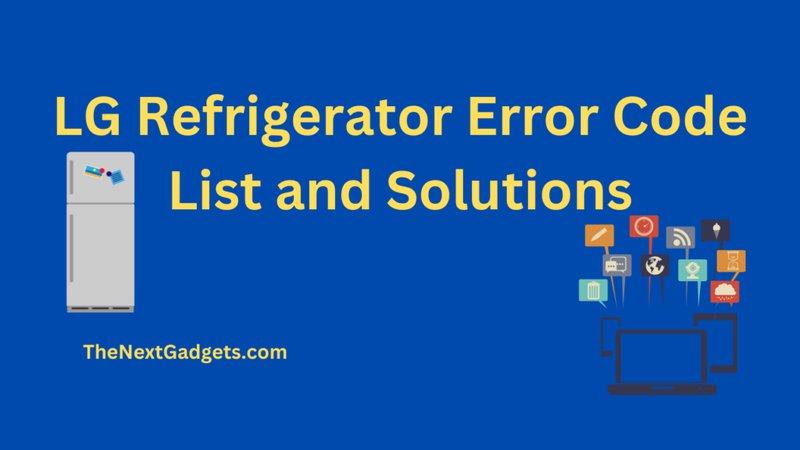
So let’s dive in, shall we? The SE error code on your LG refrigerator is trying to tell you something important. It’s like an SOS signal, signaling that there might be an issue with the refrigerator’s sensor. This sensor is crucial because it helps regulate the temperature inside your fridge. Think of it as the refrigerator’s thermostat, keeping things just right for your perishables. When the SE error pops up, it’s essentially waving a red flag that this sensor might be having trouble.
Understanding the Role of Refrigerator Sensors
Before we get into the nitty-gritty of the causes, let’s first understand what these sensors do. In essence, sensors are to your refrigerator what a thermostat is to your home. They monitor and maintain the right temperature to ensure optimal performance and the freshness of your food. Without them, your fridge would be like a car without a speedometer—just guessing how fast it’s going.
Now, these sensors are generally very reliable. However, like any technology, they aren’t immune to problems. When they start acting up, your fridge may struggle to maintain the correct temperature. This can lead to warmer-than-desired conditions and unhappy, spoiled food. In some ways, it’s like having a broken thermometer when you’re sick—you won’t get an accurate reading on how severe the fever is.
A malfunctioning sensor might seem trivial, but let’s be real—it can have major effects on how your fridge performs. If your LG refrigerator’s sensor is out of whack, it could either lead to a freezer that’s too warm or a fridge that turns into an icebox. Neither scenario is ideal for your groceries or your energy bills.
Common Causes of the SE Error Code
You might be wondering, “What exactly causes these sensors to fail?” There are a few common culprits that can lead to the infamous SE error code. One major cause is a simple wiring issue. Think of it like the wires under your desk—if they get tangled or damaged, your computer might not work correctly. Similarly, if the wiring connected to the sensors becomes frayed or disconnected, it can lead to errors.
Another possible cause is sensor failure due to wear and tear. Over time, these components can simply wear out, just like the soles of your favorite shoes. If the sensor gets faulty or stops working altogether, it sends out incorrect signals, leading your refrigerator to display the SE error code.
Additionally, environmental factors might come into play. Extreme temperatures or humidity levels where the refrigerator is stored can affect sensor performance. It’s like leaving your smartphone out in the sun or rain—it might not work as well as it should. Keeping your fridge in a stable environment helps prolong the life of its components.
How to Troubleshoot and Fix the SE Error Code
So, what should you do if you spot the SE error code on your LG refrigerator? First, take a deep breath and remember—it’s often easier to fix than you might think. Start by checking the wiring for any visible issues like breaks or disconnections. If you find something amiss, you might need to call in a professional to repair or replace the wiring.
If the wiring looks good, consider resetting your refrigerator. Unplug it for a few minutes, then plug it back in. This acts much like rebooting a computer that’s acting up. If the error persists, a faulty sensor might be the issue, and replacing it could be necessary. For this, consulting an appliance expert is advisable.
Regular maintenance can often prevent these issues before they start. Clean your refrigerator’s vents and coils, check for proper door seals, and keep the device at an appropriate temperature. These little steps can help keep your fridge running smoothly without pesky error codes.
Preventative Measures to Avoid Future SE Errors
To avoid encountering the SE error code in the future, it’s helpful to adopt some preventative measures. Regularly cleaning the inside of the fridge and ensuring that no food items block the air vents are good practices. Just like unclogging a congested drain keeps water flowing, keeping vents unblocked helps proper air circulation.
Keeping an eye on the fridge’s environment also plays a crucial role. Avoid placing it next to heat sources like ovens or direct sunlight, as this can affect how sensors function. It’s akin to not placing your laptop in a hot car—heat can cause internal havoc.
Lastly, consider scheduling regular check-ups with a professional technician to identify any potential issues before they spiral into full-blown problems. Proactive maintenance can be like a regular doctor’s check-up for your fridge—keeping it healthy and error-free.
By following these tips and understanding what might cause the SE error code, you can ensure your LG refrigerator serves you well without unexpected hiccups. And remember—those error codes are just your fridge’s way of asking for a little TLC.
